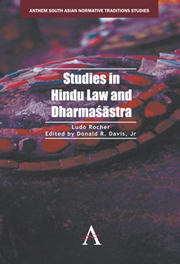Book contents
- Frontmatter
- Contents
- Foreword by Richard W. Lariviere
- Preface
- Abbreviations
- Note on the Edition
- Introduction
- PART ONE THE NATURE OF HINDU LAW
- PART TWO GENERAL TOPICS OF HINDU LAW
- PART THREE HINDU LEGAL PROCEDURE
- PART FOUR TECHNICAL STUDIES OF HINDU LAW
- Possession Held for Three Generations by Persons Related to the Owner
- The Vīramitrodaya on the Right of Private Defence
- The Technical Term Anubandha in Sanskrit Legal Literature
- The Kāmasūtra: Vātsyāyana's Attitude toward Dharma and Dharmaśāstra
- In Defense of Jīmūtavāhana
- Dāsadāsī
- The Definition of Vākparuṣya
- Janmasvatvavāda and Uparamasvatvavāda: The First Chapters on Inheritance in the Mitākṣarā and Dāyabhāga
- Karma and Rebirth in the Dharmaśāstras
- Notes on the Technical Term Sāhasa: “Fine, Pecuniary Penalty”
- Avyāvahārika Debts and Kautilya 3.1.1–11
- The Sūtras and Śāstras on the Eight Types of Marriage
- Caritraṃ Pustakaraṇe
- The Terms Niyukta, Aniyukta, and Niyoga in Sanskrit Legal Literature
- The Aurasa Son
- The Introduction of the Gautamadharmasūtra
- PART FIVE ANGLO-HINDU AND CUSTOMARY LAW
- Bibliography
- Index
The Kāmasūtra: Vātsyāyana's Attitude toward Dharma and Dharmaśāstra
from PART FOUR - TECHNICAL STUDIES OF HINDU LAW
Published online by Cambridge University Press: 05 February 2013
- Frontmatter
- Contents
- Foreword by Richard W. Lariviere
- Preface
- Abbreviations
- Note on the Edition
- Introduction
- PART ONE THE NATURE OF HINDU LAW
- PART TWO GENERAL TOPICS OF HINDU LAW
- PART THREE HINDU LEGAL PROCEDURE
- PART FOUR TECHNICAL STUDIES OF HINDU LAW
- Possession Held for Three Generations by Persons Related to the Owner
- The Vīramitrodaya on the Right of Private Defence
- The Technical Term Anubandha in Sanskrit Legal Literature
- The Kāmasūtra: Vātsyāyana's Attitude toward Dharma and Dharmaśāstra
- In Defense of Jīmūtavāhana
- Dāsadāsī
- The Definition of Vākparuṣya
- Janmasvatvavāda and Uparamasvatvavāda: The First Chapters on Inheritance in the Mitākṣarā and Dāyabhāga
- Karma and Rebirth in the Dharmaśāstras
- Notes on the Technical Term Sāhasa: “Fine, Pecuniary Penalty”
- Avyāvahārika Debts and Kautilya 3.1.1–11
- The Sūtras and Śāstras on the Eight Types of Marriage
- Caritraṃ Pustakaraṇe
- The Terms Niyukta, Aniyukta, and Niyoga in Sanskrit Legal Literature
- The Aurasa Son
- The Introduction of the Gautamadharmasūtra
- PART FIVE ANGLO-HINDU AND CUSTOMARY LAW
- Bibliography
- Index
Summary
The first sūtra of Vātsyāyana's Kāmasūtra pays homage, not only to kāma, but to all three components of the trivarga:
dharmārthakāmebhyo namaḥ. (1.1.1)
The reason for this initial statement is provided in the next sūtra:
śāstre prakṛtatvāt. (1.1.2)
Neither Schmidt's (“Weil sie in dem Lehrbuche immer wiederkehren”) nor Upadhyaya's (“The three Aims of Life that are dealt with in this Shastra”) translations adequately express the meaning of this sūtra. What Vātsyāyana claims is that he pays homage to dharma, artha, and kāma, because they are the three topics which are “genuine, relevant” (prakṛta) to a śāstra, i.e., to any śāstra.
The fact that all three elements of the trivarga are interconnected has been stressed elsewhere in the Kāmasūtra. In a sequence of sūtras which will be discussed later in this article, and in which Vātsyāyana suggests that different aspects of the trivarga shall be the primary ones in different periods of a person's life (kālaṃ vibhajya), at the same time he emphasizes that, throughout life,
anyonyānubaddhaṃ parasparasyānupaghātakaṃ trivargaṃ seveta. (1.2.1)
That means that in any period of life in which one of the elements of the trivarga is the primary one, the other two should be natural adjuncts of it, and that, under no circumstances, any one of the trivarga should be detrimental to the other two. Again, later in the same chapter:
trivargasādhakaṃ yat syād dvayor vaikasya vā punaḥ ∣
kāryaṃ tad api kurvīta na tv ekārthaṃ dvibādhakam ∣∣ (1.2.51)
- Type
- Chapter
- Information
- Studies in Hindu Law and Dharmasastra , pp. 481 - 496Publisher: Anthem PressPrint publication year: 2012

